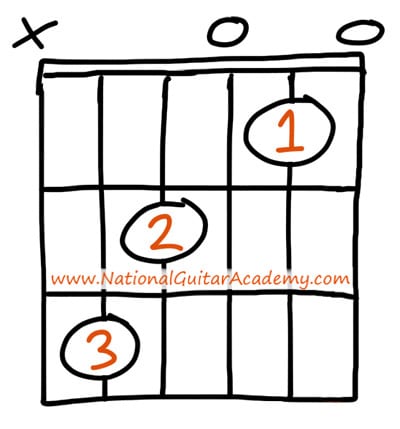Learning how to read guitar sheet music in all its forms takes time – let’s get you up to speed on each style!
Over 100,000 guitar-learners get our world-class guitar tips & tutorials sent straight to their inbox: Click here to join them
In this free lesson you will learn…
- What tablature is & how to read it
- An introduction to chord boxes
- An introduction to traditional sheet music notation
- How different techniques are illustrated through tablature
Let’s Learn How To Read Guitar Sheet Music!
Getting familiar with how to read guitar sheet music is going to help you make some serious progress, seriously fast.
It’s important to note however that as guitarists, we don’t really use the phrase ‘sheet music’ the same way that other musicians do.
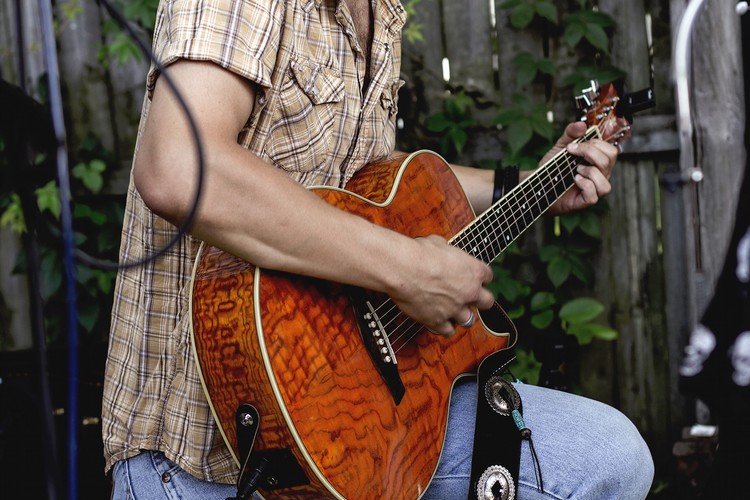
When learning how to read guitar sheet music, there are three major types of ‘sheet music’ to consider.
Guitarists generally refer to them by the following names:
- Tablature – This is usually called a “guitar tab”. This is semi-dynamic music notation laid out in a way that makes sense for guitarists.
- Chord boxes – Images of static chord shapes that show you where to place your fingers.
- Traditional musical notation (AKA ‘sheet music’) – Although it gets a bad reputation amongst guitarists, traditional notation is a fully-dynamic method of writing music. If you can read it, traditional notation will tell you basically everything you need to know about a song in order to play it. This style of notation is widely used in Classical music as well a Jazz.

We’ll spend the most time in this lesson covering tablature, mainly due to how common it is and how easy it can be to follow.
On the other hand, we can’t encourage you enough to learn each of these methods.
Knowing what chord boxes are, and the basics of classical sheet music will make you an even more well-rounded musician in the long run.
How To Read Guitar Sheet Music – Understanding The Various Types
While you might think that all ‘sheet music’ would look the same, when it comes to guitar there are a few ways it can be formatted.
Let’s break down what you need to know about how to read guitar sheet music so that you can quickly tell the different varieties apart and make sense of them. Knowledge is power!
How To Read Guitar Sheet Music: Tablature
What makes tabs different from other types of sheet music are the numbers on the line.
- Each line represents one of the strings on the guitar.
- Each number shows you which string to play at which fret.
Each line represents one of the guitar strings.
- The bottom line on the tab represents the 6th string (low E string). The thickest string.
- The top line on the tab represents the 1st string (high E string). The thinnest string.
With that then, we can determine that the notes on the strings in order are (highest to lowest):
E
B
G
D
A
E
For example, let’s take a look at this simple progression of notes:
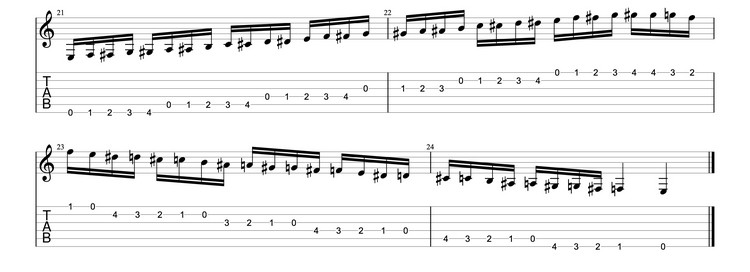
This tab above shows us that we are playing every note from the open position to the 4th fret in sequence up, then back down.
We will break down how to read this in greater detail soon. But for now, just now that if you’re looking at numbers on lines, it means you’re looking at tablature!
How To Read Guitar Sheet Music: Chord Boxes
To show chords in ‘sheet music’ form we use chordboxes.
In this format, instead of the strings being horizontal, they’re vertical.
Here’s an example chordbox:
C MAJOR
(If you don't understand the above image please read our article "How To Read Guitar Chordboxes In 60 Seconds". It will make everything clear!)
Learning how to read guitar sheet music in this way gives you a visual representation of the neck of the guitar, as though you were looking at it sitting on a stand, facing you.
The 2 horizontal lines at the top of the image are the nut of the guitar.
QUICK TIPS
- The far left vertical line is the low E string.
- The far right vertical line indicates the high E string.
- Each horizontal line represents a fret.
- Each number represents which finger you should use.
- Where the number appears is showing you where you should place the numbered finger.
✅ Stop struggling. Start making music. ✅ Learn beginner-friendly versions of every chord. This is our most popular guide and it will improve your chord ability quickly! 😎 Get a custom guitar-learning plan here: Click here for GuitarMetrics™ Learn from the world's best guitar educators: Click here for our guitar coursesLearn 12 EASY beginner chords with our popular guide

Get your own personalised guitar-learning plan 🎸
World-Class Guitar Courses 🌎
How To Read Guitar Sheet Music: Traditional Notation
As we explained in the intro, traditional sheet music involves the staff, which is what most people think of when it comes to the term “sheet music.”
Mastering playing sheet music requires you to learn each of the notes on the staff so you know exactly what to play.
This is a whole other level of learning how to read guitar sheet music, but have a look at the example below for an outline:

In this lesson on learning how to read guitar sheet music, we’re just going to cover the basics so you can look at sheet music and understand some simple melodies.
Each circle represents a different note.
- Each line does not represent a certain guitar string, unlike tablature, so following it as if it does will not work.
- Instead, each line represents a different musical note.
- Some sheet music will have numbers near the note to indicate that you should use a certain finger to play the note, but that is not always the case.
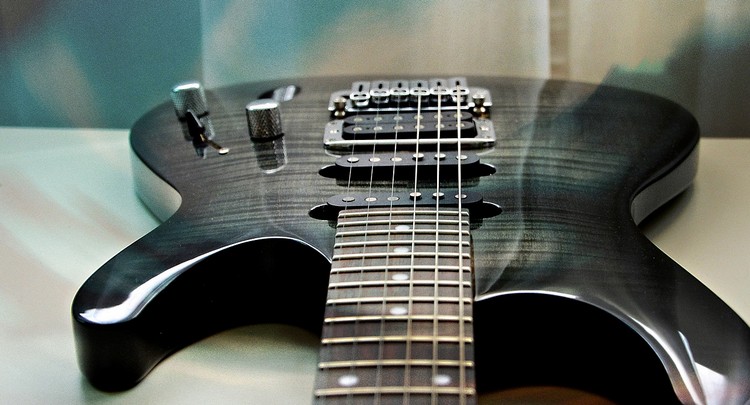
Some staffs will also have three possible symbols after the clef or before an individual note which will change the notes you play:
Sharp: ♯
Flat:♭
Natural:♮
Reading traditional music is quite a bit different than learning how to read guitar sheet music like what you primarily find online. For a more in-depth understanding of traditional notation, check out our full guide.
How To Read Guitar Sheet Music: 3 Comparisons, 1 Chord
To make it more clear, we’re going to take a look at C major chord in every form.
In tablature, we would write C major like this:

The accompanying chord box would look something like this:
C MAJOR
Traditional music notation enthusiasts will write a C major chord like so (shown three ways):

How To Read Guitar Sheet Music: Tablature In-Depth
What makes guitar tablature different from other types of sheet music is that there is less information to work with.
Some of you may think that this is a bad thing, but when you’re learning how to read guitar sheet music as a beginner, traditional notation can have too much information to work with.
- This makes tablature a simplified and easy way to learn how to pick up and play on the guitar.
- All tabs are read from left to right, so they’re easy to follow along as you learn.
When you’re looking at tabs, they are presented on this type of chart, seen below:

With tabs, there is usually an indication of what each string should be tuned to (E, A, D, G, B, E). When learning how to read guitar sheet music, this is important to make note of in every song you learn.
Not all songs use the standard tuning system that we learn on, and you’ll want to make sure your strings are tuned to the right notes or else the song will not sound right.
To be noted: when there is no indication of tuning, you can assume that the song simply has
standard tuning – E, A, D, G, B, E.
Have you tuned your guitar yet?
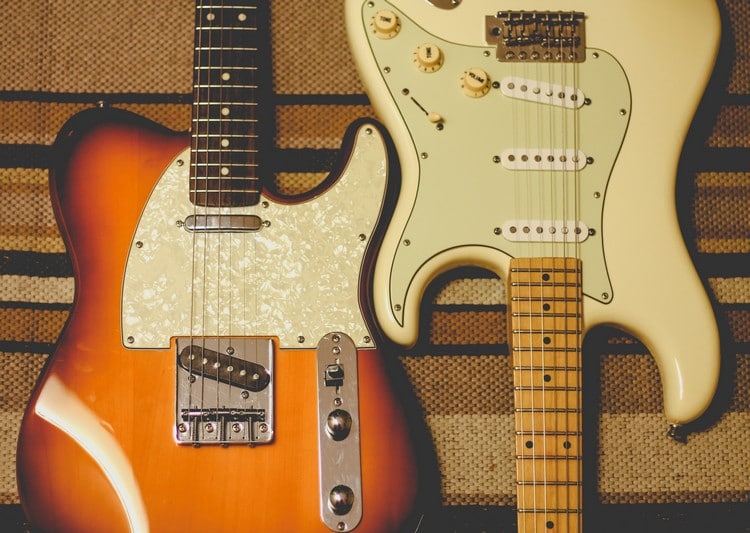
How To Read Guitar Sheet Music: Measures
The big 4/4 numbers indicate that measures are four quarter-notes long, which means there are four beats in a measure.
When these are not present, you can generally assume that the tempo of the song is 4/4.
- Learning how to read guitar sheet music takes some rhythmic study.
- Check out our article on how to play in time here.
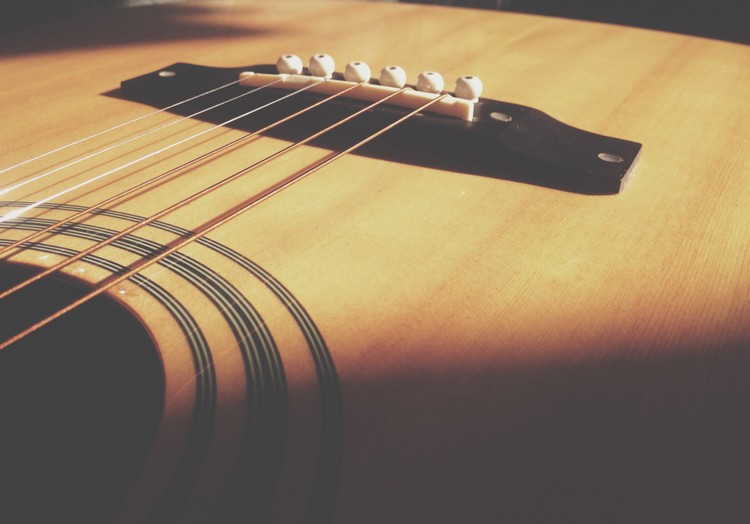
Understanding The Numbers In Tablature
One huge benefit of learning how to read guitar sheet music using tabs is the fact that you don’t need to study or learn standard sheet music.
You simply follow along and put your fingers on the indicated frets.
Understanding those numbers and how they correspond to your fretboard, however is a bit more detailed of a process.

How To Make Tablature Easier
When learning how to read guitar sheet music like tablature, one great thing you can do is to analyze the position of the tabs.
Look at the whole line of tablature to consider the most efficient finger placement, as this can save you time in hand movements due to leaving your left hand in one place instead of moving it with each individual note.
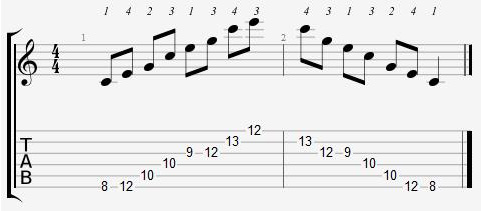
This looks complicated, but if you look at the line as a whole, you’d realize your fingers are in the same position as a C chord.
- You’d simply put your fingers in the formation of the C chord and then pick the strings according to the tabs.
- This will get easier with time, especially when you start to memorize all the major chords since many tabs will go hand-in-hand with them.
From here, let’s talk about different techniques and how they are illustrated when learning how to read guitar sheet music!
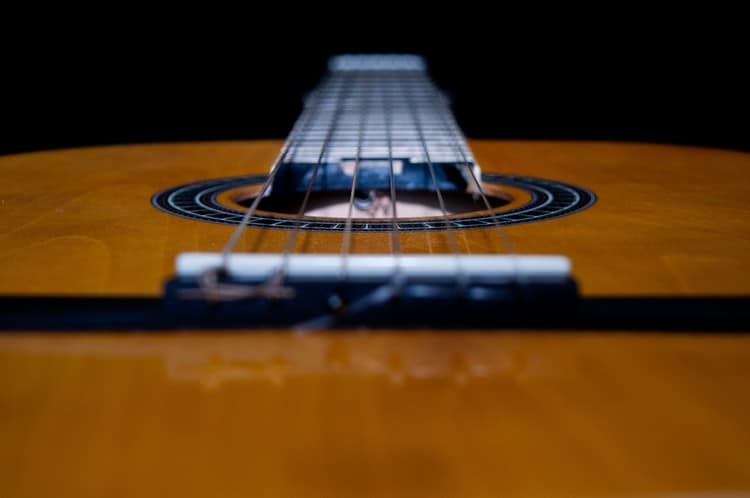
Hammer-Ons & Pull-Offs
You’ll want to make sure you practice the basics of how to read guitar sheet music before you move onto these specialized meanings in tabs. They’re slightly more advanced than simply picking the string.
Hammer-ons can be expressed in tab music in a few different ways. Sometimes they’ll look like “7h9” or “7^9” within tabs.
- Other times, they are expressed with a U shape as seen below.
- The way to play these is to first play the note as you normally would, then “hammer” onto the next fret with your other finger (typically the ring finger).
- Conversely, pull-offs are expressed using symbols like “9p7” or “9^7” within tabs, or with a U shape similar to a hammer-on, pictured below.

String Bends, Slides & Muting
While these symbols are less common than pull offs and hammer ons, you’ll see them from time to time in some tabs. With that, it’s important to know what they mean.
Learning how to read guitar sheet music involves understanding the dynamic symbols used, and is necessary especially for lead guitarists in the making.
Muting and palm muting may sound similar, but they are quite different.
Mutes are displayed using X’s, whereas palm muting is displayed with a ‘PM’ above the top tab line.

A “/” means to slide your finger up. With a hammer-on or pull-off, you remove or add a finger on the string.
- With this symbol, you physically slide to the indicated fret.
- This can look like”3/5″ or even “3/5\3”.
- That second example means you would pick the note on the third fret, slide it up to the fifth fret, and then back down to the third fret without picking the string again.

A “b” in between two fret numbers, such as “14b15”, means to bend the string up or down until it sounds like the second fret number.
- There are a variety of different bends that we can make use of.
- Try experimenting with different expressions in your bending when learning how to read guitar sheet music for lead guitar!
Check out the tab below to see how these concepts are illustrated:
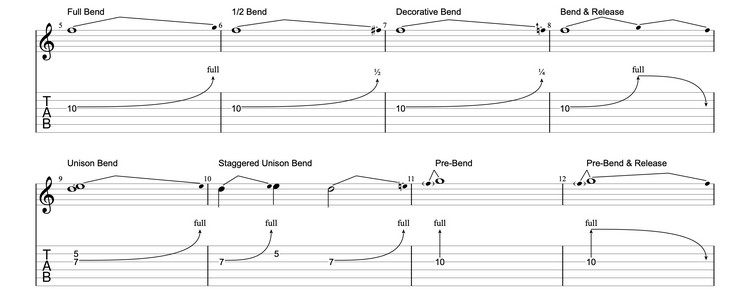
Download our lead guitar cheat-sheet to make things easier
It's hard to understand which scales work with which keys.
So we created a cheat-sheet! A key and scale-finder that you can use again and again.

Get your personalised guitar-learning plan 🎸
Get a custom guitar-learning plan here: Click here for GuitarMetrics™
World-Class Guitar Courses 🌎
Learn from the world's best guitar educators: Click here for our guitar courses
How To Read Guitar Sheet Music: Chord Boxes
As opposed to tabs and traditional notation, chord boxes are essential to learning each of the basic chords on a guitar.
Each string in the chord is meant to be strummed all at once, so anything you see on a chord box is played at the same time. Each chord represents one whole note, typically (four beats).
Let’s go back to the example chord box we used at the beginning of this lesson:
C MAJOR
This chord box means you put your fingers on the:
B string – 1st fret
D string – second fret, and
A string – 3rd fret.
This is also known as a C chord.
- The numbers indicate the fret your fingers should be on.
- The “X” at the top of the chord box indicates to not play that string, whereas the “O” indicates that you should play that string open.
- In the above diagram, you’re strumming five strings at once.
- In some instances when learning how to read guitar sheet music, you may see these boxes at the top of tablature, notation and lyric sheets among other places!
If you want a deeper understanding of them, check out our full guide.

Learning How To Read Guitar Sheet Music Takes Practice!
With practice, you’ll get better at learning how to read guitar sheet music in every form.
Outside of hiring an instructor, there are many free guitar apps, and websites with free tabs that will help you get better at playing the guitar and learn new songs.
- The best thing you can do is pick easy songs by artists you love to begin with.
- Music that you’re familiar with will make it easier to follow along as you play.
- Most guitar players at some point will switch between all three types of sheet music, but a large majority of your learning will be with tabs. Regardless, learn how to read guitar sheet music in every form!
Recommended Resources
Want to get deeper into learning how to read guitar sheet music? Check out some of our other guides below:
- How To Read Guitar Chords: An Essential Guide
- How To Read Guitar Tabs
- 14 Easy Guitar Chords For Beginners
- How To Play Lead Guitar
- Guitar Theory: The 4 Step System For Rapid Progress
What Type of Guitarist Are You?
Take our 60-second quiz & get your results: Take The Quiz
Join the world's best online guitar school 🌎
- Get your own personalised guitar learning plan (customised just for YOU).
- World-class online guitar courses. Learn at your own pace.
- Community Campus & Learning Forum - A friendly community! Connect with our team & students. 😊
- Beginner Song library with chordsheets, tabs and tips. (Songs suitable for all levels!)
- Regular live streams, seminars and Q&A sessions - Learn from world-class guitar educators. Get all your questions answered!
Click here to learn more about National Guitar Academy membership 
Cool Guitar T-shirts 😎
Look cooler! Check out our merch: Click here to see our merch store
Want free guitar tips and video lessons delivered to your inbox?
Join over 100,000 guitar-learners and subscribe to our guitar-tips-by-email service. (It's free.)
We'll send you a series of lessons that will move you to the next level of your guitar journey.
Learn how everything fits together quickly, easily and effectively. We share ninja tips (for instant fun!) but also timeless fundamentals that will deepen your understanding.

Popular Lessons
How To Learn Guitar: An 11-Step Programme For Beginners
How To Choose The Perfect Beginner Guitar
More Cool Guitar Stuff
Learn about National Guitar Academy: About Us
Join us on Facebook for daily guitar tips.
Listen to our Learn Guitar Podcast for rapid guitar progress.
Check out our free chord lessons.
Get our best guitar tips & videos
Where should we send it?
Where should we send it?
Get our best guitar tips & videos

